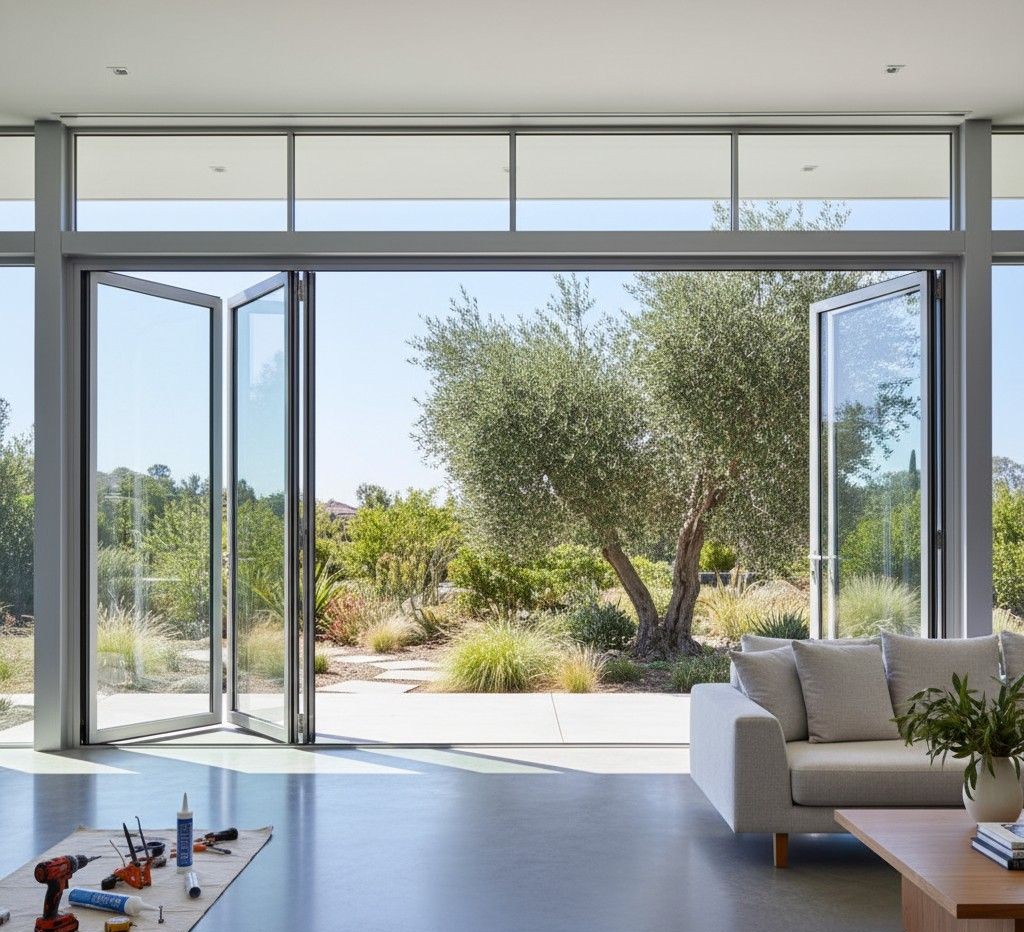Fold-up windows, also called bi-fold windows, are becoming a favored choice for modern residential and commercial spaces. Their ability to create seamless indoor-outdoor transitions, maximize natural light, and offer flexible ventilation has made them highly desirable among architects, builders, and homeowners alike.
These systems not only elevate design but also enhance functionality by opening entire wall sections with ease. As a result, they have become a defining feature in contemporary projects where space optimization, energy performance, and visual appeal are critical factors.
Key Takeaways:
- Fold-up windows maximize space, ventilation, and aesthetics with aluminum frames, customizable panels, and energy-efficient glazing.
- Proper installation requires precise leveling, sealing, and fastening to ensure durability, smooth operation, and weather resistance.
- Long-term performance depends on regular maintenance, including hinge lubrication, seal replacement, and track cleaning.
Benefits of Installing Fold-Up Windows
Before diving into the installation, it’s important to understand the advantages:
- Space Efficiency – Panels neatly fold to one or both sides.
- Aesthetic Appeal – Creates expansive openings for a sleek, modern look.
- Durability –Aluminum and reinforced frames ensure long-term stability.
- Customization Options – Sizes, glazing, and finishes can be tailored for different projects.
- Energy Performance – Thermal breaks and weather-sealed frames improve efficiency.
Essential Tools and Materials for Professional Installation
When installing fold-up windows, precision is critical. Having the right tools and materials ensures a secure fit, structural stability, and long-term performance. Below is a recommended checklist for professionals:
- Measuring Equipment – Tape measure, laser level, and square for accurate dimensions.
- Power Tools – Drill with masonry and metal bits, impact driver for heavy-duty anchoring.
- Fastening Materials – Galvanized screws, wall plugs, and anchors for structural support.
- Sealing & Insulation Products – High-quality weatherproof sealant, flashing tape, and expanding insulation foam.
- Alignment Aids – Shims, wedges, and clamps to ensure the frame is plumb and level.
- Safety Equipment – Gloves, safety goggles, and hearing protection for secure handling.
Pro Tip: Always confirm the compatibility of fastening hardware with the wall type (concrete, brick, timber, or steel framing) to avoid premature loosening or structural weaknesses.
Step-by-Step Installation Process
1. Preparing the Opening
- Confirm that the wall opening matches the window’s specifications.
- Check the structural support to ensure it can bear the load.
- Level and square the sill, sides, and head of the opening.
2. Installing the Frame
- Position the frame in the opening with temporary shims.
- Use a level to align the frame vertically and horizontally.
- Secure the frame with screws through the pre-drilled holes.
- Apply sealant around the perimeter to prevent air or water infiltration.
3. Attaching the Tracks & Hinges
- Install the top and bottom tracks as per the manufacturer’s specifications.
- Align hinges carefully to support smooth folding action.
- Test for uniform spacing across the panels.
4. Installing the Fold-Up Panels
- Mount each panel onto the hinges starting from one side.
- Secure fasteners and check alignment after each panel.
- Adjust rollers (if applicable) for smooth gliding.
5. Sealing & Insulation
- Apply weatherproof sealant along exterior edges.
- Use insulation foam between frame and wall gaps.
- Install flashing where necessary to divert water away from openings.
6. Final Adjustments & Testing
- Open and close the windows multiple times to test movement.
- Check lock mechanisms for secure operation.
- Clean frames and glass to ensure a flawless finish.
Common Mistakes to Avoid
- Improper Leveling – Can cause panels to jam or not close properly.
- Skipping Sealant Application – Increases risk of leaks and drafts.
- Using Incorrect Hardware – Weak screws can compromise stability.
- Neglecting Structural Support – Especially in wide openings.
Comparison: Fold-Up Windows vs. Sliding & Casement Windows
| Feature | Fold-Up Windows | Sliding Windows | Casement Windows |
| Opening Width | Full, unobstructed | Limited to half | Limited by hinge |
| Aesthetic Appeal | Modern, expansive | Moderate | Classic |
| Ventilation | Flexible, wide | Partial | Controlled |
| Installation Complexity | High | Moderate | Low |
| Space Requirement | Requires folding clearance | Minimal | Swing clearance |
For cost-conscious buyers, it’s useful to understand bi-fold window pricing before choosing between systems.
Long-Term Care and Performance Optimization
Fold-up windows are engineered for durability, but their performance relies on proper upkeep. To maximize product lifespan and maintain energy efficiency, professionals and property owners should follow these guidelines:
- Lubricate hinges and rollers every 6–12 months.
- Clean tracks to prevent dirt buildup.
- Replace worn-out seals or gaskets promptly.
Detailed recommendations are available in this maintenance guide.
Strategic Considerations for Procurement and Specification
For wholesalers, architects, and builders, selecting the right fold-up window system extends beyond design aesthetics. Decision-making should weigh multiple technical and logistical factors:
- Certification and Compliance – Verify that products meet international building standards (thermal performance, wind resistance, impact resistance where required).
- Customization Capabilities – Explore options for frame colors, glazing thickness, thermal breaks, and locking systems to meet specific project demands.
- Bulk Supply and Logistics – Ensure reliable lead times, consistent quality in large orders, and cost-effective shipping solutions.
- After-Sales Support – Access to technical assistance, replacement parts, and professional installation guidance adds long-term value.
- Warranty and Service Agreements – Prioritize manufacturers offering transparent coverage on both materials and workmanship.
A variety of products can be tailored to meet these needs, from commercial applications to residential renovations.
Manufacturer Profile: Oridow’s Role in the Global Market
Oridow is a China-based manufacturer specializing in aluminum windows and doors, with a strong focus on customized fenestration systems for international markets. Their portfolio supports both residential and commercial projects, offering flexible solutions that meet diverse architectural requirements.
- Global Certifications – Ensures compliance with building codes in multiple regions.
- Customization Expertise – Tailored designs to match project-specific dimensions, glazing, and finishes.
- Scale & Efficiency – Ability to handle bulk procurement with consistent quality assurance.
Solutions include uPVC windows for budget-conscious projects and aluminium bifold windows designed for pass-through areas in kitchens or commercial spaces.
Conclusion
Fold-up windows are a smart investment for projects requiring versatility, design appeal, and functional efficiency. When installed correctly and maintained with care, they deliver long-lasting performance and elevate architectural value across residential and commercial applications.
For professionals, choosing a supplier that balances certified quality, customization, and large-scale supply capability ensures the best results for both small-scale projects and major developments.
Frequently Asked Questions (FAQs)
1. Are fold-up windows energy efficient?
Yes, modern fold-up windows are designed with thermal breaks, weather-sealed frames, and insulated glazing that help improve energy performance. When installed correctly, they minimize heat loss in winter and reduce heat gain in summer.
- Use double or triple glazing for maximum efficiency.
- Ensure proper sealing around the frame to prevent drafts.
- Opt for low-E coated glass to reflect heat.
2. What kind of maintenance do fold-up windows require?
Maintenance is relatively simple, focusing on keeping moving parts smooth and the frame sealed. Regular upkeep ensures longevity and prevents operational issues.
- Lubricate hinges and rollers every 6–12 months.
- Clean tracks to prevent dirt buildup.
- Replace worn-out seals or gaskets promptly.
3. Can fold-up windows be customized for different projects?
Yes, fold-up windows are highly customizable, which makes them a popular choice for both residential and commercial projects. Customization includes dimensions, finishes, glazing options, and hardware.
- Frame finishes: Powder-coated, anodized, or wood-grain look.
- Glazing options: Single, double, or laminated glass.
- Panel configuration: Bi-folds opening inwards or outwards.
4. How do fold-up windows compare to sliding windows?
Fold-up windows provide a full, unobstructed opening, whereas sliding windows usually only open halfway. This makes them better for spaces requiring maximum airflow and seamless transitions.
- Fold-Up: Expansive opening, modern design.
- Sliding: Limited to 50% opening, easier installation.
- Casement (comparison): Classic look, but requires swing clearance.
5. Are fold-up windows suitable for commercial spaces?
Yes, they are widely used in restaurants, cafés, offices, and showrooms due to their ability to create open, inviting spaces. They also provide practical solutions for high-traffic areas.
- Ideal for serving counters and shopfronts.
- Adds versatility for seasonal indoor-outdoor setups.
- Enhances aesthetic appeal in modern architecture.
6. What are common mistakes to avoid during installation?
Improper installation can lead to poor performance, leaks, or jamming. Professionals should pay close attention to leveling, sealing, and hardware compatibility.
- Failing to level the frame properly.
- Using incorrect fasteners for wall type.
- Skipping sealant and flashing, leading to water ingress.
7. How do I choose the right supplier for fold-up windows?
Choosing the right supplier is critical for quality and compliance. Look for a manufacturer with certifications, customization options, and a proven track record in large-scale supply.
- Check certifications for international standards.
- Ensure bulk procurement support for wholesalers.
- Verify warranty and after-sales service availability.





